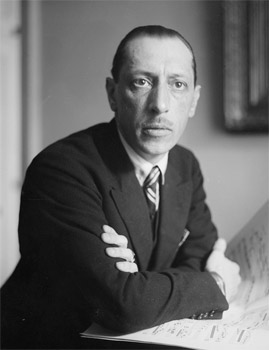
Biography
The son of a distinguished Russian singer, Stravinsky spent his earlier years in Russia. He studied music briefly with Rimsky-Korsakov but made a name for himself first in Paris with commissions from Sergei Diaghilev, for whom he wrote a series of ballet scores.He spent the years after the Russian Revolution of 1917 in Western Europe and in 1939 moved to the United States of America. There in the postwar years he turned from a style of eclectic neo-classicism to composing in the twelve-note technique propounded by Schoenberg. A versatile composes, inventive in changing styles, he may be seen as the musical counterpart of the painter Picasso. Stravinsky made an immediate impression in Paris with his score for L’oiseau de feu (The Firebird, 1910), for the Ballets Russes of Diaghilev. There followed the very Russian Petrushka (1911), set in a Russian fair-ground, and the succès de scandale of Le sacre du printemps (The Rite of Spring, 1913).
After works on a smaller scale in war-time that includes L'Histoire du Soldat (The Tale of Soldier), Stravinsky turned again to ballet for Dyagilev in Pulcinella (1920) and Les Noces (The Wedding, 1923). Later ballets include Apollon musagète (1927), Le Baiser de la fée (1928), Jeu de Cartes (1936), Circus Polka (1942), Orpheus (1948) and Agon (1957).
The Latin opera-oratorio, with a text translated from Cocteau, Oedipus Rex was first staged in 1928, while the opera The Rakes Progress, neoclassical in form and based on the engravings of Hogarth, with a libretto by W.H. Auden and Chester Kallman, was staged in Venice in 1951.
Stravinsky's orchestral music includes symphonies, suites from some of the ballets, and two suites arranged from sets of easy piano pieces. Concertos of various kinds include a 1936 Concerto for piano, wind, timpani and double basses, an Ebony Concerto for jazz band and a Violin Concerto Stravinsky's chamber music includes some arrangements of orchestral works, in particular two versions of music from Pulcinella, one for violin and piano and a second for cello and piano, under the title Suite italienne.
Stravinsky's published writings include Chronicle of My Life (London, 1936), Conversations with Igor Stravinsky (with Robert Craft, New York, 1959), Dialogues and a Diary (with Robert Craft, New York, 1963), and Themes and Episodes (with Robert Craft, New York, 1966).



